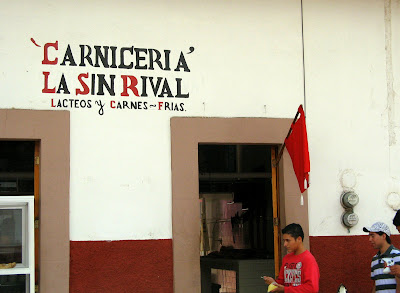Until very recently, I'd never heard of Conservas Santa Rosa at Santa Rosa de Lima, Guanajuato; a women's co-op dedicated to conserving and selling fruits of that area.
We had the opportunity to pay a visit to the shop, located on the main street of upland Santa Rosa, at an elevation of over 8000 feet above sea level. It's about a half hour by car from Guanajuato Capital, on the highway to Dolores Hidalgo.
If I had ever visited Oregon state, which I've not, then I could say that the area resembles that state.
The shop is small, neatly and attractively set up. The walls are lined with shelves displaying the co-op's various products. Above are jars of beautiful, selected pear halves and peaches; below, an extensve assortment of marmalades of several types. Fresa is popular, and is avalable in different sizes. Durazno, chabacano, ciruela, piña, nopal, xoconostle, mango and guayaba. I may have missed a few.
Another shelf unit holds sweet fruit licores, such as tamarindo, of which I was not fond for its sweetness. There are others.
I was drawn to a shelf near the back door holding very attractive jalapeños encurtidos, but I can make those myself. More interesting were the Conservas Santa Rosa's Chiles Chipotles, in glass jars which showed off the chiles' dark, smoldering and smoky potential to advantage.
All the products are packaged in attractive glass jars with brown paper caps and twine. They would make good gifts. We bought about 10 items and have already given way 3 of 4.
This is a recommended excursion out of Guanajuato. You can visit the Valenciana mines; Las Conservas Santa Rosa, the fancy Alfarería Mayólica; and have a nice comida at one of the famed local restaurants, sch as Restaurante de La Sierra, Rancho Enmedio, or where we did, at La Cabaña de Lolita.
Website: http://www.ccg.org.mx/santa.HTM
Product Catalog.
Email: conservasanta@yahoo.com
These are their hours of operation:
All I know is that weekends, they open
sabado 10 AM to 6 PM
domingo 12 PM to 5 PM
The tienda may be open only on weekends.
Their website says that you can try some of the mermeladas in Tok's Restaurants; various locations in La República Mexicana.
















